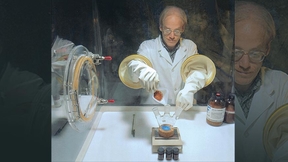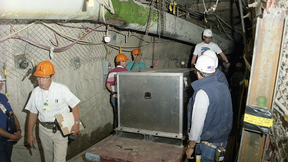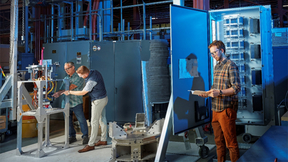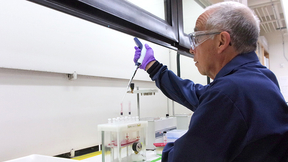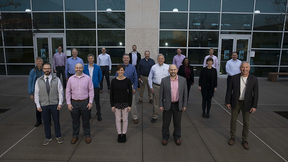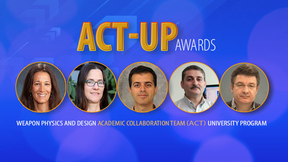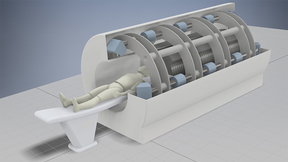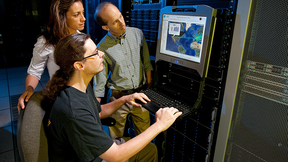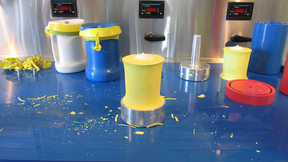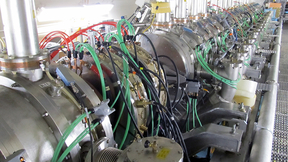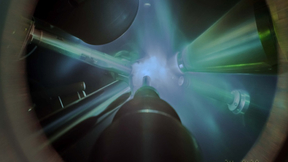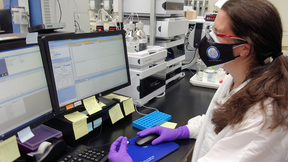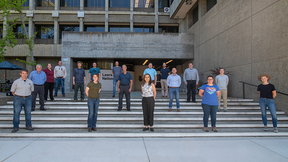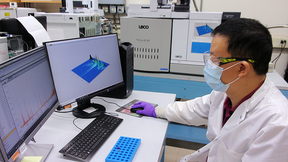Back
Strategic Deterrence
Developing technology to keep the nuclear stockpile safe, secure and reliable
The last nuclear test, code-named Divider, took place 30 years ago, on Sept. 23, 1992. That year, President Bush declared a temporary moratorium on nuclear testing, which became permanent in 1995, during the Clinton administration. This ending of the era of nuclear testing coincided with a Presidential announcement of the beginning of stockpile stewardship. As the decision…
30 years later, Hunters Trophy participants recall LLNL’s final underground nuclear test
The year was 1992. At 10 a.m. on a balmy September morning in the desolate Nevada desert, a countdown began. And for a few brief moments, the ground violently shook. In a NASA-esque control room at the Nevada Test Site (NTS), Lawrence Livermore National Laboratory (LLNL) engineer Jack Cutting watched as monitors and oscilloscopes began sending back data collected on the…
Researchers successfully execute Miramar experiment to support U.S. stockpile modernization efforts
A multi-institutional team of researchers and collaborators successfully executed an integrated vessel confinement system (VCS) experiment at Lawrence Livermore National Laboratory (LLNL), as part of an experimental campaign to study how nuclear materials react to high explosives without conducting a traditional nuclear test. The experiment — dubbed Miramar — was an…
EMC: Celebrating three decades of explosive innovation
For 30 years, the Laboratory’s Energetic Materials Center (EMC) has built critical expertise, enabling scientific investigation in support of the nuclear deterrent and keeping the nation safe from emerging explosives and nuclear proliferation. On June 23, the EMC will celebrate the 30th anniversary of its founding. Recognizing that expertise in high explosives (HEs) — a…
Polymer Production Enclave fully operational
Through a strong partnership between Lawrence Livermore National Laboratory (LLNL) and Kansas City National Security Campus (KCNSC), a new concept of concurrent engineering and accelerated development became a reality with the start of an enclave designed to deliver key components for the U.S. nuclear warhead modernization programs. Completed in 2021 as a state-of-the-art…
LLNL garners 'A' grade in OPCW environmental test
Even after taking highly stressful exams in college, grades can still be important. Just ask researchers at Lawrence Livermore National Laboratory’s (LLNL) Forensic Science Center (FSC). Every fall, chemists and other researchers from the FSC spend two weeks of long days undertaking the Organisation for the Prohibition of Chemical Weapons (OPCW) environmental proficiency…
LLNL and Y-12 partner to accelerate production, innovation for U.S. nuclear deterrent
Lawrence Livermore National Laboratory (LLNL) and the Y-12 National Security Complex have teamed up to rapidly modernize legacy technology and production methods of crucial components for the U.S. nuclear deterrent. A leading example of this collaboration is the recent successful installation and testing of the electron beam cold hearth melter (EBCHM) – a machine that can…
Lab’s ACT-UP awards focus on collaborative university research
With a focus on increasing joint research efforts between Lawrence Livermore National Laboratory and universities, the Lab’s Weapon Physics and Design (WPD) Academic Collaboration Team University Program (ACT-UP) has presented this year’s ACT-UP awards. Now in its third year, the ACT-UP awards were created to encourage and advance strategic partnerships among universities…
Radiation to cancer patients in a ‘FLASH’
Researchers at Lawrence Livermore National Laboratory (LLNL) have shown for the first time the potential for linear induction accelerators (LIAs) to deliver effective, targeted doses of “FLASH” radiation to cancer patients. The new technique selectively kills cancer cells with minimal damage to healthy cells. The approach is outlined in a Scientific Reports paper. For…
Nuclear weapons technology for a new generation of policymakers
Policymaking for nuclear security requires a strong grasp of the associated technical matters. That grasp came naturally in the early decades of the nuclear era, when scientists and engineers were deeply engaged in policymaking. Yet in the last few decades, the scientists and engineers who conceived, built and executed the programs that created the existing U.S. nuclear…
NNSA taps Dell Technologies to provide expanded computing resources for stockpile stewardship
The Department of Energy’s National Nuclear Security Administration’s (DOE/NNSA’s) Lawrence Livermore National Laboratory (LLNL) announced the awarding of a subcontract to Dell Technologies for additional supercomputing systems to support NNSA’s nuclear deterrent mission. In partnership with Los Alamos National Laboratory (LANL) and Sandia National Laboratories (SNL), the…
Lawrence Livermore’s pressing operations with high explosives reach new milestones
High explosive (HE) research, development, test and evaluation work at Lawrence Livermore National Laboratory (LLNL) continues to meet the needs of the nation on behalf of the National Nuclear Security Administration (NNSA). One specific effort is the HE pressing capability, which is a critical component of the LLNL’s national security mission. The scope of the Lab’s HE…
Diagnostic capability allows scientists to create X-ray movies
Lawrence Livermore National Laboratory (LLNL) scientists are working on a new diagnostic capability that will provide, for the first time, the ability to make X-ray radiographic movies. The first experiment testing the principle, dubbed the Bipolar Reset Experiment (BIRX), was conducted at LLNL’s Flash X-Ray (FXR) deep-penetration radiographic facility at Site 300. The…
Lawrence Livermore team captures data from unarmed Minuteman III test launch
A team from Lawrence Livermore National Laboratory (LLNL) successfully collected data from the recent operational test of an Air Force Global Strike Command unarmed Minuteman III intercontinental ballistic missile (ICBM) launched from Vandenberg Space Force Base. The purpose of the ICBM test launch program is to validate and verify the safety, security, effectiveness and…
Researchers focus on how tantalum behaves at high pressure and temperature
Lawrence Livermore National Laboratory (LLNL) researchers have explored high-pressure behavior of shock-compressed tantalum at the Omega Laser Facility at the University of Rochester’s Laboratory for Laser Energetics (LLE). The work showed tantalum did not follow the predicted phase changes at high pressure and instead maintained the body-centered cubic (BCC) phase until…
LLNL earn 'A' grade in OPCW biomedical proficiency test
It wasn’t an easy road, but Lawrence Livermore National Laboratory (LLNL) Forensic Science Center scientists earned an “A” grade in the Organisation for the Prohibition of Chemical Weapons’ (OPCW) recent biomedical proficiency test. In addition to the usual complexity of the sample preparations and analysis, the Livermore scientists received their proficiency test samples…
LLNL delivers eight Scorpius pulsed-power modules to Los Alamos
Lawrence Livermore National Laboratory (LLNL) recently delivered eight prototype pulsed-power modules for testing to Los Alamos National Laboratory (LANL), marking completion of a key milestone in a multi-lab effort to develop Scorpius, a next-generation particle accelerator for X-ray imaging. The line replaceable units (LRU) will provide the precise energy pulses needed…
Shining a Bright Light on Plutonium
As the nation’s adversaries move to close the gap in weapon capabilities, Lawrence Livermore’s mission remains focused on supporting stockpile stewardship. Assessing weapon readiness becomes more challenging, however, with an aging stockpile and a workforce decades removed from the last live nuclear weapon tests. Computer simulations can model weapon behavior but require…
LLNL hosts Test Site Verification Team orientation
Lawrence Livermore National Laboratory (LLNL) hosted an in-person orientation meeting recently for members of the National Nuclear Security Administration’s (NNSA) Test Site Verification Team (TSVT). TSVT is sponsored by NNSA’s Office of Nuclear Verification (ONV) Nuclear Compliance Verification (NCV) Program. The TSVT is led by Kim Knight from LLNL and Emily Schultz…
LLNL's Forensic Science Center earns 'A' grade in OPCW environmental test
This fall, a score of scientists from Lawrence Livermore National Laboratory's (LLNL) Forensic Science Center (FSC) will start two weeks of long days to undertake the Organisation for the Prohibition of Chemical Weapons (OPCW) environmental proficiency test. Livermore scientists have been taking the proficiency tests each October since 2001, with LLNL serving as one of two…


